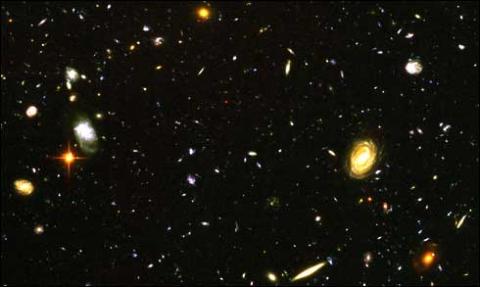Our galaxy, the Milky Way, is typical: it has hundreds of billions of stars, enough gas and dust to make billions more stars, and at least ten times as much dark matter as all the stars and gas put together. And it’s all held together by gravity.
Like more than two-thirds of the known galaxies, the Milky Way has a spiral shape. At the center of the spiral, a lot of energy and, occasionally, vivid flares are being generated. Based on the immense gravity that would be required to explain the movement of stars and the energy expelled, the astronomers conclude that the center of the Milky Way is a supermassive black hole.
Other galaxies have elliptical shapes, and a few have unusual shapes like toothpicks or rings. The Hubble Ultra Deep Field (HUDF) shows this diversity. Hubble observed a tiny patch of sky (one-tenth the diameter of the moon) for one million seconds (11.6 days) and found approximately 10,000 galaxies, of all sizes, shapes, and colors. From the ground, we see very little in this spot, which is in the constellation Fornax.
Formation
After the Big Bang, the Universe was composed of radiation and subatomic particles. What happened next is up for debate - did small particles slowly team up and gradually form stars, star clusters, and eventually galaxies? Or did the Universe first organize as immense clumps of matter that later subdivided into galaxies?
Collisions
The shapes of galaxies are influenced by their neighbors, and, often, galaxies collide. The Milky Way is itself on a collision course with our nearest neighbor, the Andromeda galaxy. Even though it is the same age as the Milky Way, Hubble observations reveal that the stars in Andromeda's halo are much younger than those in the Milky Way. From this and other evidence, astronomers infer that Andromeda has already smashed into at least one and maybe several other galaxies.
Recent Discoveries
| Date |
Discovery |
|---|
| September 22, 2020 |
Data Sonification: Sounds from Around the Milky Way |
| August 27, 2020 |
Hubble Maps a Giant Halo Around the Andromeda Galaxy |
| August 25, 2020 |
NASA Missions Explore a ‘TIE Fighter’ Active Galaxy |
| August 10, 2020 |
Ring of Stellar Wildfire (NGC 1614) |
| July 13, 2020 |
A frEGGs-cellent Discovery (J025027.7+600849) |
| June 29, 2020 |
Birds of a Feather (NGC 2275) |
| June 15, 2020 |
A Bright Find (PLCK G045.1+61.1) |
| June 1, 2020 |
Stellar Snowflakes (NGC 6441) |
| May 18, 2020 |
Stellar Glitter in a Field of Black (ESO 461-036) |
| May 11, 2020 |
Bending the Bridge Between Two Galaxy Clusters (Abell 2384) |
| April 6, 2020 |
Rings Upon Rings (NGC 2273) |
| February 20, 2020 |
Beyond the Brim, Sombrero Galaxy's Halo Suggests a Turbulent Past |
| February 3, 2020 |
Nature's Grand Design (NGC 5364) |
| January 28, 2020 |
Chandra Spots a Mega-Cluster of Galaxies in the Making |
| January 27, 2020 |
Bars and Baby Stars (NGC 7541) |
| January 16, 2020 |
XMM-Newton Discovers Scorching Gas in Milky Way's Halo |
| January 6, 2020 |
Hubble Surveys Gigantic Galaxy (UGC 2885) |
| January 5, 2020 |
New View of Milky Way’s Center |
| January 5, 2020 |
Distant Galaxy Group Driving Ancient Cosmic Makeover |
| December 31, 2019 |
Galactic Pyrotechnics From 23 Million Light Years Away (NGC 4258) |
| December 18, 2019 |
GISMO Instrument Maps Inner Milky Way, Sees Cosmic ‘Candy Cane’ |
| December 17, 2019 |
Galaxy Gathering Brings Warmth (NGC 6338) |
| December 16, 2019 |
Discs and Bulges (IC 2051) |
| December 10, 2019 |
How to Shape a Spiral Galaxy (NGC 1068) |
| December 9, 2019 |
Galactic Diversity (NGC 3175) |
| November 20, 2019 |
Hubble Studies Gamma-Ray Burst with the Highest Energy Ever Seen (GRB 190114C) |
| November 18, 2019 |
Emission Versus Absorption (NGC 3749) |
| November 18, 2019 |
A Weakened Black Hole Allows its Galaxy to Awaken |
| November 11, 2019 |
A Rival to the Milky Way (NGC 772) |
| November 7, 2019 |
The Sunburst Arc (PSZ1 G311.65-18.48) |
| October 24, 2019 |
Mega-Cluster of Galaxies in the Making |
| October 21, 2019 |
A Familiar Sight (IC 4653) |
| October 17, 2019 |
Super Spirals Spins Super Fast |
| October 10, 2019 |
Audit of the Milky Way’s Gas Flow Rates Reveals a Mysterious Surplus of Inflowing Gas |





